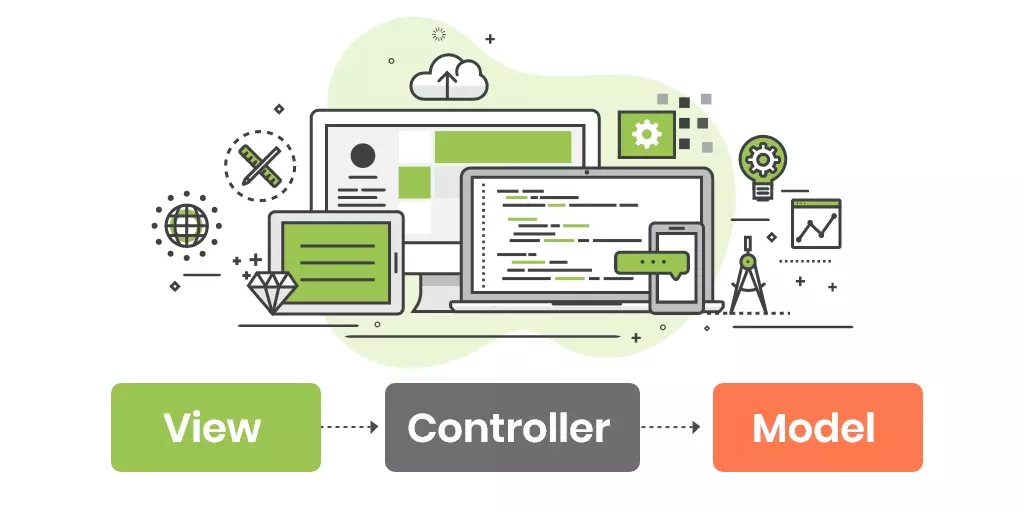The Benefits of The MVC Architecture in Software Development

If you’ve ever seen the internet in its infancy, you’ll know that it wasn’t the most sophisticated of places.
The dynamic websites of today take their root from humble beginnings. Take a cue from YouTube. In the beginning it looked something like this:
Now it looks something like this:

Websites made during the first era of the internet were relatively simple. They were a mix of HTML and CSS, and they worked well for their time.
If you look at Google in its early stages, or any other website from the 90s for that matter you’ll see what I’m trying to say.
Oh, how time flies. Modern websites are complex web applications with lots of dynamic elements communicating with one another.
Just take a look at Google Analytics and how it processes website data in real time:

It’s not just the integration of programming languages that’s worth the discussion with modern websites. JavaScript, its frameworks, and other languages have played a huge part in making modern websites “modern”. That’s no lie.
At the same time, the HTML and CSS code itself has gone through iterations with the introduction of HTML5, CSS3, and frameworks like Bootstrap, SASS, and LESS.
Developers are trying day in and day out to simplify their development workflows.
Also Read:
- 9 Best Practices to Secure Your SaaS-Based Applications
- SaaS vs PaaS vs IaaS: What You Need to Know with Examples
- PHP vs JavaScript For Web Development
Besides the introduction of frameworks, they’ve also developed development patterns that they use to divide their workflows. The end goal? Simplify things as much as they can.
One such way to simplify the development process is through the Model View Controller (MVC) architecture. This post is here to explain the advantages of the MVC architecture and how it speeds up your workflows significantly.
Let’s look at the MVC architecture in-depth, shall we?
The MVC Architecture Explained: 
The MVC architecture simplifies complexities with coding. It divides up the workflow, helping developers focus on each aspect of the Model, View, and Controller one at a time.

Let’s discuss each individual item:
- The Controller is responsible for handling server requests coming in from the user. Its primary goal is to relay information to and from the Model, and the View. When a server request is initiated, the Controller asks the Model to fetch the data from the database.
- The Model is the part of the architecture responsible for handling the data logic. It ensures that the data is organized and put into one place. This is to avoid any discrepancies with the data when the Controller asks for it. When requested by the Controller, the Model fetches and returns the data to the Controller.
- The Controller at this point fetches the data, verifies it, and then asks the View to process it.
- The View ensures data presentation. In simple terms, when requested by the Controller to process the data, it starts to render HTML and the code which then presents the data to the user.
This whole process takes milliseconds and starts at the moment you open up an app or type in a website to interact with.
For the website development process, the MVC Model is good to have because it aids in the development process, making it quicker and more organized.
How the MVC Architecture Improves Web Development

1. Faster development process:
The primary benefit of using the MVC architecture is it’s quicker and parallel development lifecycle.
For example, if one developer is working on the View, the other is simultaneously working on the Controller. This helps reduce the workload on each individual developer and makes the development process rapid and efficient.
With proper division of project development, the MVC architecture also leads to better accountability from developers.
2. Ability to provide multiple Views:
Users interact with their version of the web applications for different purposes and in different ways. This leads to better development of the “View” of the MVC.
To be specific, you need to develop multiple Views to facilitate the user interactions. This isn’t a laborious task since there is no reason to duplicate the code.
3. Support for asynchronous technique:
Asynchronization with other languages is possible through the MVC structure.
It integrates with JavaScript and its associated frameworks, thus making it work seamlessly with site-specific elements. Through the MVC architecture, you are able to develop an application that loads quickly and efficiently.
4. The modification does not affect the entire Model:
A modern web application is not dormant. It goes through changes in its source code and UI from time to time.
Now, whether you’ve employed a software development company or done the changes yourself, the MVC architecture helps make those changes easier.
Adding, and managing new Views is easier and more controlled since the Model and Controller work independently of the View.
5. MVC Model returns the data without formatting:
The MVC Model’s main purpose is to fetch data. It doesn’t apply any formatting to it. This means that the data can be processed through HTML, but also through Macromedia Flash, or Dreamweaver.
6. SEO friendly development platform:
With the MVC architecture, you can develop SEO friendly web pages. This is because the environment for fetching the data makes it quick and efficient.
Furthermore, it’s integration with JavaScript drives the point of “faster site speed” home. Quick loading websites are an important SEO metric. They are essential in reducing bounce rates.
Conclusion:
The MVC design is a godsend for developers and users (without them knowing it). It ensures that the user experience of the website is smooth and controlled.
On the other hand, for developers and project managers, it makes the software projects quicker since their implementation doesn’t require so much overhead. They can be completed in less time without losing the efficiency. Moreover, for marketers and SEO specialists, it means developing applications that are SEO-friendly from the ground-up.
At Codup, we develop website applications with the help of the MVC architecture. Therefore, if you want your products to be perfect from the outset, Contact Us today.



